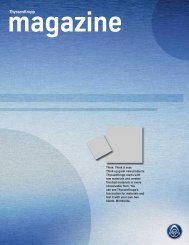2005-2006 Financial Statements and Management Report
2005-2006 Financial Statements and Management Report
2005-2006 Financial Statements and Management Report
Create successful ePaper yourself
Turn your PDF publications into a flip-book with our unique Google optimized e-Paper software.
24<br />
AUTOMOTIVE CONTINUED<br />
ITS PORTFOLIO OPTIMIZATION<br />
IN <strong>2005</strong>/<strong>2006</strong>.<br />
The Chassis business unit increased its sales by 6% to €3.7 billion in the reporting period. This<br />
pleasing development was due among other things to a significant increase in systems business. As<br />
well as the start of production of axle assembly plants in Leipzig <strong>and</strong> Mexico, the three plants of ThyssenKrupp<br />
Budd Systems in London, Columbia <strong>and</strong> Fowlerville recorded significantly higher orders. At<br />
ThyssenKrupp Umformtechnik, ThyssenKrupp Presta SteerTec USA <strong>and</strong> ThyssenKrupp Bilstein Suspension,<br />
new orders from various German auto manufacturers went into production. ThyssenKrupp<br />
Tallent Chassis also reported increasing order numbers. Sales of the business unit were adversely<br />
impacted by lower orders from us manufacturers in particular. Divestments also had a negative effect<br />
on sales.<br />
The Powertrain business unit achieved sales of €1.7 billion. Favorable factors were the start of production<br />
on various crankshaft <strong>and</strong> camshaft orders, price increases in South America, <strong>and</strong> exchange<br />
rate effects. In the Transmission & Driveline Components business, numerous programs were launched<br />
for German, French <strong>and</strong> American auto manufacturers. Lower truck output <strong>and</strong> massive competition in<br />
the area of 4-cylinder car crankshafts had a negative impact on sales.<br />
Earnings<br />
The Automotive segment returned a loss of €174 million, compared with a profit of €118 million a year<br />
earlier. The loss was mainly due to restructuring expense <strong>and</strong> impairment charges on goodwill <strong>and</strong><br />
property, plant <strong>and</strong> equipment. The impairment charges resulted primarily from the initiation of the<br />
disposal of the North American body <strong>and</strong> chassis business, but also from the deterioration in the situation<br />
in Germany for body lines <strong>and</strong> tool/die making. Non-recurring expense for restructuring <strong>and</strong> impairment<br />
charges amounted to €339 million. This was set against disposal gains of €35 million.<br />
Operating profits in the Body business unit, i.e. disregarding non-recurring expense, fell short of<br />
the prior-year level. This was mainly due to declining workloads at the North American <strong>and</strong> French<br />
stamping plants <strong>and</strong> higher scrap prices at the American foundries.<br />
The Chassis business unit increased its operating income, thanks to improved operating performances<br />
at the British stamping plants <strong>and</strong> in the areas of steering <strong>and</strong> suspension.<br />
The Powertrain business unit failed to match the high operating earnings of the previous year. Profits<br />
were impacted by the development of the exchange rate for the Brazilian real against the us dollar.<br />
Significant events<br />
The Automotive segment further optimized its portfolio in <strong>2005</strong>/<strong>2006</strong>. In the usa, the plastics plants<br />
<strong>and</strong> the ThyssenKrupp Stahl Company aluminum foundry were sold. The closure of the Detroit plant of<br />
ThyssenKrupp Budd began on September 30, <strong>2006</strong>. In addition, the operations of Aluminiumfeinguss

















